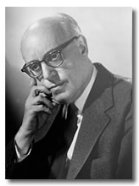Dr. Emanuel Revici and selenium anti-cancer compounds
Selenium Therapy
Steve Coerper
It's not alternative medicine; it's real medicine. Caroline Stamu, M.D.

 |
|
|
The name of Dr. Emanuel Revici should be a household word when discussing effective treatment for cancer, but unfortunately, Dr. Revici’s work has been largely ignored by the American medical establishment. Dr. Revici earned recognition for his landmark discovery of pharmacologically active selenium compounds and did significant research on the application of his discovery to the effective treatment of cancer.
He was not the first to suspect that selenium or selenium compounds could be used effectively for cancer treatment. As early as 1910, Dr. August von Wasserman of Berlin observed that vital cancer cells were capable of reducing selenite. Five years later, the American Medical Journal published a report about the efficacy of selenite when administered orally in subtoxic doses. The report documented a complete disappearance of small subcutaneous tumors.
However, it was Dr. Revici who developed and implemented therapies that capitalized on these discoveries, and his ideas of using nontoxic compounds and "individually-guided therapy" earned him support and respect in both American and European American medical communities. Unfortunately, his creative methods were not recognized or promoted by many medical organizations in the United States.
During the years following World War II, Dr. Revici performed clinical tests with human subjects. He preferred organic selenium compounds rather than possibly toxic selenium. The results of his tests were extremely encouraging, with remissions of many years in a number of otherwise “hopeless” patients.
Decades before chemotherapy became one of the three regimens most commonly used by oncologists, Dr. Revici developed an effective system of chemotherapy of negligible toxicity. The focus of Dr. Revici's study was the behavior of lipids in abnormal cellular metabolisms. He identified two basic types of tumors: catabolic, or fatty acid based tumors, and anabolic, or sterol-based tumors. He used sterols on catabolic tumors, and fatty acids to treat anabolic tumors.

|
While inorganic selenium compounds are generally toxic, there are organic forms that are nontoxic and can be safely administered. Of course, with a critically ill patient for whom conventional therapies have been ineffective, higher risks for 'unproven' treatments become more acceptable. Using nontoxic selenium compounds, the only adverse reaction noted is occasional inflammation around the site of the malignancy.
Using these non-toxic compounds combined with individually guided therapy, he eventually earned acceptance and support. His record of “miracle” cures tended to make him the “Doctor of Last Resort” for many patients who were not responding to traditional care.
Dr. Revici had little patience with the bureaucratic delays that are the core of the FDA’s approval process. With his primary concern being the welfare of his patients, he simply felt it wrong to withhold therapeutic agents from those who did not respond to conventional therapies. Accordingly, when his own experiments confirmed the safety and efficacy of an agent, he administered it to his patients.
Dr. Revici wrote a highly technical book, published in 1961, that is no longer in print. The title is Research in Physiopathology As Basis For Guided Chemotherapy with special application to cancer*.
The American Cancer Society still remains unconvinced. Claiming an apparent lack of credible studies, they see the Revici method as "unproven" and urge patients to use other therapeutic methods. Some, of course, suspect a commercial interest that would not want to see a treatment for cancer that is both effective and inexpensive.
Treatment currently costs about $500 for the initial consultation and the treatment, with follow-up visits of $95. Some insurance plans offer reimbursement.
Dr. Revici died in January of 1998 at the age of 101, five years after retiring from 73 years of active medical practice.
The Doctor Who Cures Cancer by William Kelley Eidem centers on diagnostic foods, breathing techniques, and imbalances in one’s life that may be precursors to or predictors of cancer. It is a ‘must read’ for anyone who either has cancer or knows someone who does.
 STUMBLE IT!
STUMBLE IT!